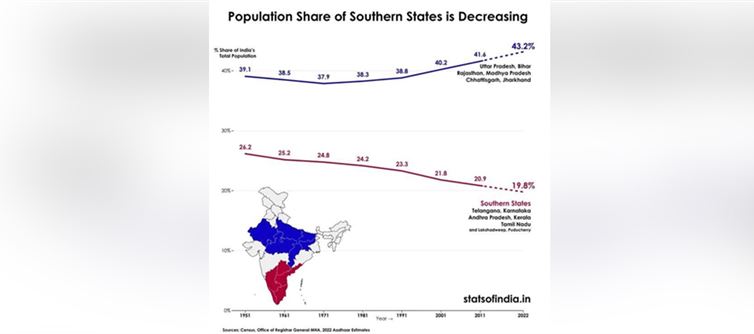
The graph accompanying the tweet illustrates a clear divergence over seven decades. The southern states—comprising Telangana, karnataka, Andhra Pradesh, kerala, tamil Nadu, Lakshadweep, and Puducherry—have seen a steady decline in their share of India’s total population, dropping from 26.2% in 1951 to 19.8% in 2022. Conversely, the northern states, including Uttar Pradesh, Bihar, Rajasthan, Madhya Pradesh, Chhattisgarh, and Jharkhand, have increased their share from 39.1% to 43.2% over the same period. This trend is visually reinforced by a map highlighting the northern and southern regions in contrasting blue and red hues, respectively.
Several factors contribute to this demographic shift. Southern states have been pioneers in education, healthcare, and family planning, leading to lower fertility rates. States like kerala and tamil Nadu have achieved total fertility rates (TFR) well below the replacement level of 2.1, a trend supported by decades of effective government policies and societal shifts toward smaller families. In contrast, northern states, particularly Uttar Pradesh and Bihar, have higher fertility rates, driven by cultural preferences for larger families, slower adoption of family planning, and socioeconomic challenges such as poverty and limited access to education.
Urbanization and migration also play a role. The South’s rapid economic development has attracted labor from the North, reducing the local population growth rate as people move for work while contributing to the North’s population stability. Additionally, lifestyle changes in the south, including rising infertility rates and the growth of IVF centers, as noted in related X posts, may further depress population growth.
Pros of the trend
• Economic Advantage: The southern states’ lower population growth has coincided with higher per capita income and better human development indices. This demographic dividend has fueled economic progress, with states like karnataka and tamil Nadu becoming hubs for technology and manufacturing.
• Resource Sustainability: A slower population increase allows southern states to manage resources like water, food, and infrastructure more effectively, avoiding the strain seen in densely populated northern regions.
• Social Development: Lower fertility rates correlate with improved education and health outcomes, as seen in Kerala’s high literacy rates and life expectancy, setting a model for national development.
Cons of the trend
• Political Representation: The decline in population share threatens the southern states’ representation in the Lok Sabha. India’s delimitation process, frozen since 1971 and due for revision post-2026, may reduce the number of parliamentary seats for the south, transferring power to the north, as highlighted by users like @yogi_2024 on X.
• Economic Disparity: As the south contributes significantly to national taxes and GDP, a reduced political voice could lead to inequitable resource allocation, with funds flowing to the more populous north, a concern raised by @Humansofbimaru
.
• Aging Population: With lower birth rates, southern states face the prospect of an aging population, potentially straining pension systems and healthcare, while the north’s younger demographic could dominate the workforce.
Several factors contribute to this demographic shift. Southern states have been pioneers in education, healthcare, and family planning, leading to lower fertility rates. States like kerala and tamil Nadu have achieved total fertility rates (TFR) well below the replacement level of 2.1, a trend supported by decades of effective government policies and societal shifts toward smaller families. In contrast, northern states, particularly Uttar Pradesh and Bihar, have higher fertility rates, driven by cultural preferences for larger families, slower adoption of family planning, and socioeconomic challenges such as poverty and limited access to education.
Urbanization and migration also play a role. The South’s rapid economic development has attracted labor from the North, reducing the local population growth rate as people move for work while contributing to the North’s population stability. Additionally, lifestyle changes in the south, including rising infertility rates and the growth of IVF centers, as noted in related X posts, may further depress population growth.
Pros of the trend
• Economic Advantage: The southern states’ lower population growth has coincided with higher per capita income and better human development indices. This demographic dividend has fueled economic progress, with states like karnataka and tamil Nadu becoming hubs for technology and manufacturing.
• Resource Sustainability: A slower population increase allows southern states to manage resources like water, food, and infrastructure more effectively, avoiding the strain seen in densely populated northern regions.
• Social Development: Lower fertility rates correlate with improved education and health outcomes, as seen in Kerala’s high literacy rates and life expectancy, setting a model for national development.
Cons of the trend
• Political Representation: The decline in population share threatens the southern states’ representation in the Lok Sabha. India’s delimitation process, frozen since 1971 and due for revision post-2026, may reduce the number of parliamentary seats for the south, transferring power to the north, as highlighted by users like @yogi_2024 on X.
• Economic Disparity: As the south contributes significantly to national taxes and GDP, a reduced political voice could lead to inequitable resource allocation, with funds flowing to the more populous north, a concern raised by @Humansofbimaru
.
• Aging Population: With lower birth rates, southern states face the prospect of an aging population, potentially straining pension systems and healthcare, while the north’s younger demographic could dominate the workforce.




 click and follow Indiaherald WhatsApp channel
click and follow Indiaherald WhatsApp channel